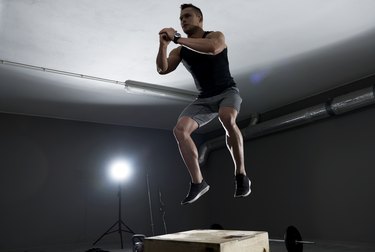
The story of the tortoise and the hare is analogous to muscle strength and endurance. The hare may be fast, but the patience of the tortoise allows it to win the race. In the same way, your muscles might be strong, but if they don't have enough endurance, your strength may not be very helpful.
To find out how good your muscle endurance is, there are tests you can do for different parts of the body. Unlike strength tests, which are intense but only last for a short period of time, these endurance tests take mental fortitude. Most endurance tests use your bodyweight as resistance. There are reliable tests for your upper body, lower body, and core muscles.
Video of the Day
Video of the Day
Read More: Muscular Endurance Training
Sit-Up Test
This test is used in the military and many physical education programs. It's an easy movement to learn and most people have the abdominal strength to complete more than a few reps.
The guidelines for the Army Physical Fitness test state that in two minutes, men and women aged 17 to 21 should be able to do 53 sit-ups. That's considered the beginner level of ab muscle endurance.
As age increases, the number of sit-ups required to pass the test slowly decreases.
HOW TO DO IT: Lie on your back on the ground. Bend your knees and plant your feet flat. Have a partner hold your feet down on the ground. Fold your arms across your chest and sit up, bringing your chest as close to your knees as possible.
Do as many reps as possible until you're too exhausted to complete a full repetition. According to a 2015 study published in SpringerPlus, you shouldn't put a time limit on the test.
The researchers found that a one-minute sit-up test didn't test muscle endurance very well because some subjects could keep going beyond one minute. To understand how much endurance your ab muscles have, keep going until you're completely exhausted.
Read More: Cardiovascular & Muscular Endurance
Partial Curl-Up Test
The curl-up is an abdominal endurance test. While the sit-up is widely used as a muscle endurance test, it might not be as accurate as the curl-up. The sit-up allows you to use your hip flexors to assist in the movement, whereas the curl-up isolates the abs.
HOW TO DO IT: Lie on your back on the ground. Bend your knees and plant your feet flat, like you're going to do a sit-up. Place your arms flat on the ground, reaching toward your feet. Have a partner put a piece of tape in front of your middle finger, then another piece of tape 10 centimeters in front of that.
Breathe out, push your lower back into the ground and curl your head and shoulders up off of the ground. Reach your hands, keeping them flat on the ground, until your middle finger hits the second strip of tape. Then, lie back down. Repeat to the point of exhaustion. 25 repetitions in a minute is considered excellent.

Push-Up Test
For the chest, shoulders and triceps, this is one of the best muscle endurance tests. If you're feeling confident, perform this test using your feet as the pivot point. However, if push-ups aren't easy for you, do the test from your knees.
In the Army, male recruits from ages 17 to 21 have to do at least 35 push-ups in two minutes. Females of the same age have to do 13. The requirements for both genders decrease as recruits get older.
HOW TO DO IT: Start at the top of a push-up position with your elbows straight and knees or feet on the ground. Lower yourself, keeping your back straight, until your chin touches the ground. Then, press back up to the top. That counts as one repetition. Keep going until the point of exhaustion and count the number of repetitions.
Bosco Repetitive Jump Test
The larger muscles of your lower body, the quadriceps, hamstrings and glutes, are more taxing to test. They use more energy and greater blood flow. You'll realize the difference after finishing the Bosco Repetitive Jump Test. It can be almost as taxing on your lungs as your legs.
A 2007 study in the Brazilian Review of Sports Medicine found that male volleyball players jump an average of 50 times in the minute-long test. For non-athletes, that number will be lower.
HOW TO DO IT: Start standing with your hands on your hips. For one minute, you'll keep your hands on your hips and jump as many times as possible. Squat down until your knees are at a 90-degree angle, then jump as high as you can each repetition. The most accurate way to do this test is on a vertical jump mat, that can measure how high you jump each repetition.

Wall Squat Test
This test requires you to hold one position for as long as possible. Your legs will burn and it will be uncomfortable. Try to drift away and image that you're in a happy place as your legs slowly fatigue. The test is for your legs, but most specifically targets the quadriceps muscles on the top of your thigh.
HOW TO DO IT: Start by standing and leaning against a smooth wall. Slide down the wall and walk your feet forward until your knees are at a 90-degree angle. Keep your back flat against the wall. Make sure your heels stay down on the ground. To make it more challenging, lift one foot off of the ground.
According to an article from the National Register of Personal Trainers, men who can hold this position for more than 102 seconds are considered "excellent." Women have to hold the same position for at least 60 seconds to get the same distinction.
- Top End Sports: Bosco Repeat Vertical Jump
- Journal of Strength and Conditioning Research: Associations of maximal strength and muscular endurance test scores with cardiorespiratory fitness and body composition.
- Idea Fit: Buff Up Your Muscular-Fitness Testing Skills
- Military.com: Army PFT Push-up Score Chart
- Military.com: Army PFT Sit-up Score Chart